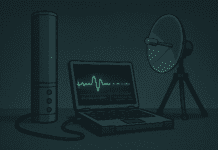This post is also available in:
 עברית (Hebrew)
עברית (Hebrew)
Scientists from the International Astronomical Union (IAU) announced that one of the brightest objects in the night sky is BlueWalker 3, the world’s largest communications satellite meant to test a 100-satellite constellation designed to provide broadband internet. A new paper published in the journal “Nature” details scientists’ observations of BlueWalker 3’s brightness over 130 days, showing that it is now one of the brightest objects in the night sky.
In yet another example of astronomers criticizing the negative impact of satellites (mainly satellite constellations) on astronomical observations, Meredith Rawls, co-author of the paper, warned that if things continue as they are, we could one day lose the ability to conduct ground-based astronomy.
“BlueWalker 3 and other bright satellites represent a fundamental change in the night sky, with the potential to affect observers worldwide,” explained Rawls, adding that the negative impacts stem from the number and brightness of the satellites.
According to Interesting Engineering, one of the worst-case scenarios for this overcrowding of orbital space is the disastrous Kessler Syndrome — a phenomenon where space debris crashes into satellites, causing more debris, which then crashes into more satellites, in a destructive cascading effect in Earth’s orbit.
Rawls also expressed her skepticism over debris collection efforts, saying she does think they will be necessary, but they are not a substitute for prioritizing space sustainability. “I don’t know if any of the current prototype technologies are feasible at scale, and I’d hate to see all our resources poured into this instead of creative ways to share satellite hardware or improve connectivity without launching yet another constellation.”
When it comes to actions taken to deal with the situation, an AST SpaceMobile representative outlined a list of mitigation efforts, including plans to equip its next-generation satellites with anti-reflective materials, share celestial location data to help astronomers plan observations, and avoid broadcasts within or adjacent to the US National Radio Quiet Zone (NRQZ). The company is also working with NASA and certain astronomy working groups to develop advanced industry solutions, including potential operational interventions.
Furthermore, although BlueWalker 3 is one of the brightest objects in the night sky, it is still just one part of a much larger problem of density and light pollution in low-earth orbit. An example that illustrates this problem is fact that SpaceX’s Starlink satellites have had to make more than 50,000 collision avoidance maneuvers combined in the past year, and the number is only expected to increase.


























